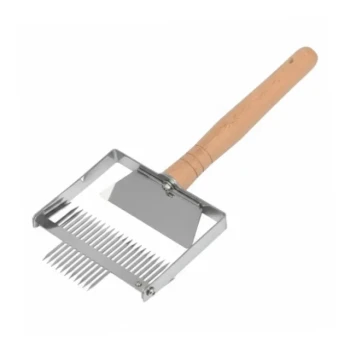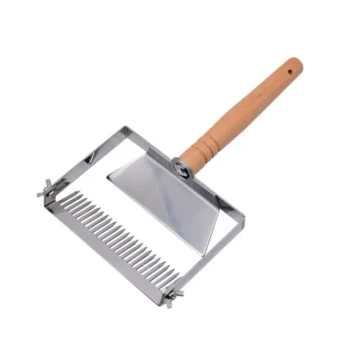In beekeeping, a honey super is a dedicated box placed on top of a beehive where the colony stores surplus honey. It is essentially the hive's pantry, filled with removable frames that beekeepers harvest. Its primary role is to separate the honey intended for collection from the main living and brood-rearing area of the colony, ensuring a clean and efficient harvest.
The fundamental purpose of a honey super is to create a distinct, easily accessible area for surplus honey collection. By keeping this space separate from where the queen lays her eggs, beekeepers can harvest pure honey without disrupting the colony's crucial brood-rearing activities.

The Hive's Structure: Where the Super Fits
To understand the honey super's role, you must first understand the basic layout of a modern beehive, which is typically a vertical stack of boxes.
The Brood Box: The Colony's Engine Room
The bottom one or two boxes of the hive are the brood chambers. This is the heart of the colony where the queen lays her eggs and the worker bees raise the next generation of bees (the brood).
Bees also store pollen and some honey here for their immediate use, but this area is primarily for raising young.
The Queen Excluder: A Critical Gateway
Directly on top of the brood box, beekeepers often place a queen excluder. This is a flat screen with gaps large enough for worker bees to pass through but too small for the larger queen.
This simple device is critical. It confines the queen to the brood boxes, preventing her from laying eggs in the frames designated for honey collection.
The Honey Super: The Surplus Pantry
Any box placed above the queen excluder is a honey super. Worker bees travel up through the excluder to deposit nectar into the honeycomb frames inside these supers.
Because the queen cannot access this area, the frames in the super will be filled exclusively with honey, making the harvest clean and straightforward.
The Super's Role in Efficient Honey Production
The honey super isn't just a box; it's a management tool that enables modern beekeeping and efficient honey production.
Timing with the Honey Flow
Beekeepers add honey supers to the hive during a "honey flow"—a period, typically in spring and summer, when flowers are producing abundant nectar.
Adding this extra space at the right time encourages the bees' natural instinct to forage and store far more food than the colony needs for its immediate survival.
Simplifying the Harvest
By concentrating the surplus honey in these specific boxes, the beekeeper can remove an entire super for harvesting without significantly disturbing the brood nest below.
This separation ensures that the collected honey is pure and free of eggs or larvae, which would complicate the extraction process and contaminate the final product.
Common Pitfalls in Super Management
While simple in concept, the timing and management of honey supers are critical to both the hive's health and the size of your honey harvest.
Adding a Super Too Early
Placing a super on the hive before the colony is strong enough can be counterproductive. The bees will have a large, empty space to patrol and regulate temperature, which can stress a smaller colony.
Adding a Super Too Late
If a beekeeper waits too long to add a super during a strong honey flow, the bees may run out of storage space. This can lead to the brood nest becoming clogged with honey, a condition known as being "honey-bound," which leaves the queen with no room to lay.
A honey-bound hive is a primary trigger for swarming, where the queen and half the bees leave to find a new home.
Forgetting the Queen Excluder
Failing to use a queen excluder can result in the queen moving into the honey supers and laying eggs. This creates a difficult harvest, as the frames will contain a mix of honey and developing bees.
Making the Right Choice for Your Hive
The way you manage your honey supers depends directly on your beekeeping goals.
- If your primary focus is maximizing honey yield: Use multiple supers and add them proactively at the start of a strong honey flow to give the colony ample storage space.
- If your primary focus is colony health and preventing swarms: Add a super only when the existing boxes are 70-80% full to ensure the bees always have room to expand.
- If your primary focus is a clean and simple harvest: Always use a queen excluder between the top brood box and your honey supers to guarantee brood-free honey frames.
Ultimately, properly managing your honey supers is the bridge between simply keeping bees and successfully producing a clean, bountiful honey harvest.
Summary Table:
| Aspect | Key Information |
|---|---|
| Primary Function | Dedicated box for surplus honey storage, separate from the brood-rearing area. |
| Key Component | Used with a queen excluder to keep the queen out, ensuring frames are filled with pure honey. |
| Management Timing | Added during a honey flow when the brood box is 70-80% full to prevent swarming and maximize yield. |
| Common Pitfall | Adding a super too late can lead to a "honey-bound" hive, a primary trigger for swarming. |
Ready to optimize your honey production with the right equipment?
As HONESTBEE, we supply commercial apiaries and beekeeping equipment distributors with the durable, high-quality honey supers and queen excluders essential for a productive and healthy operation. Our wholesale-focused operations are designed to support your business's growth and efficiency.
Contact our team today to discuss your apiary's needs and discover how our beekeeping supplies can help you achieve a cleaner, more bountiful harvest.
Visual Guide

Related Products
- Langstroth Honey Bee Box Hive Boxes for Different Depths
- Professional 500g Sectional Comb Honey Frame System for Beekeeping
- High-Efficiency Diamond Maze Bee Escape for Clearing Supers
- Economy Small Scale Honey Dryer Dehumidifier Thickening Machine
- Australian Langstroth Beehive Boxes for Beekeeping Wholesales
People Also Ask
- How is checking honey supers in a Langstroth hive different from inspecting Honey Flow supers? A Guide to Disruptive vs. Non-Invasive Methods
- How deep is a medium bee box? Unlock the Key to a Versatile and Manageable Hive
- Why do you need two bee hives? Boost Your Apiary's Success with Smart Risk Management
- What is the purpose of the boxes in a Langstroth hive? A Guide to Modular Beekeeping Success
- How does a hive box work? A Guide to the Langstroth Hive System for Beekeepers



















